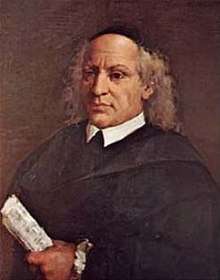Leonardo Vinci
Leonardo Vinci (1690 – 27 May 1730) was an Italian composer, best known for his operas.

Life and career
He was born at Strongoli[1] and educated at Naples under Gaetano Greco in the Conservatorio dei Poveri di Gesù Cristo. He first became known for his opere buffe in Neapolitan dialect in 1719; he also composed many opere serie. He was received into the Congregation of the Rosary at Formiello in 1728. He died in May 1730. Vinci is rumoured to have been poisoned by a jealous husband in the wake of an ill-advised affair, a story which is given by several reliable authorities without evident contradictions.[2]
Vinci's opere buffe, of which Li zite 'ngalera (1722) is generally regarded as the best, are full of life and spirit; his opere serie, of which Didone Abbandonata (Rome, 1726) and Artaserse (Rome, 1730) are the most notable, have an incisive vigour and directness of dramatic expression praised by Charles Burney. The well-known aria "Vo solcando," from Artaserse, is a good example of his style. In 2015 Decca released a Parnassus Arts Productions recording of his 3-act opera seria Catone in Utica (Rome, 1728).
Operas
- Le doje lettere (1719)
- Lo cecato fauzo (1719)
- Lo scagno (1720)
- Lo scassone (1720)
- Lo Barone di Trocchia (1721)
- Don Ciccio (1721)
- Li zite 'ngalera (1722)
- La festa di Bacco (1722)
- Publio Cornelio Scipione (1722)
- Lo castiello sacchiato (1722)
- Lo labberinto (1723)
- Semiramide (1723)
- Silla dittatore (1723)
- Farnace (1724)
- La mogliera fedele (1724)
- Turno Aricino (1724)
- Ifigenia in Tauride (1725)
- La Rosmira fedele (1725) also known as Partenope (1725)
.jpg) Vinci's manuscript of Partenope
Vinci's manuscript of Partenope - Il trionfo di Camilla (1725)
- Elpidia (1725)
- L'Astianatte (1725)
- Didone abbandonata (1726)
- Siroe, Re di Persia (1726)
- L'asteria (1726)
- Ernelinda (1726)
- Gismondo, Re di Polonia (1727)
- La caduta dei Decemviri (1727)
- Il Medo (1728)
- Catone in Utica (1728)
- Flavio Anicio Olibrio (1728)
- Alessandro nell'Indie (1729)
- Farnace (1729)
- La Contesa dei Numi (1729)
- Massimiano (1729)
- Artaserse (1730)
Other works
In addition to operas, Vinci wrote a few cantatas, sonatas, a serenata, and two oratorios (Oratorio di Maria dolorata ca. 1723 and Oratorio per la Santissima Vergine del Rosario ca. 1730). His sonata in D major for flute and basso continuo is still played today. He composed two sonatas for the recorder in addition to a recorder concerto in a minor.
Selected recordings
- Fileno - Soprano Cantatas Mesta Oh Dio, tra queste selve. Mi costa tante lacrime. Amor di Citerea. Parto, ma con qual core. Emanuela Galli & Francesca Cassinari, Stile Galante, Stefano Aresi. With work wrongly attributed to Vinci by Alessandro Scarlatti Fille, tu parti? Oh Dio! Pan Classics 2011.
References
- "Leonardo Vinci - Italian composer". Retrieved 10 September 2016.
- Kurt Sven Markstrom The operas of Leonardo Vinci, Napoletano 2007 Page 344 "..causes, such as poison. Although the story of Vinci's poisoning cannot be proven, it cannot be disproved, as is the case of similar stories connected with the deaths of Pergolesi and Mozart. Because we have this story from several reliable authorities without any obvious contradictions, one must let the story stand as is, within the realm of possibility."
Sources
- Opera Glass
- This entry was originally from the 1911 Encyclopædia Britannica.
External links
| Wikimedia Commons has media related to Leonardo Vinci. |
- Leonardo Vinci at the Encyclopædia Britannica
- Free scores by Leonardo Vinci at the International Music Score Library Project (IMSLP)
- The Mutopia Project has compositions by Leonardo Vinci